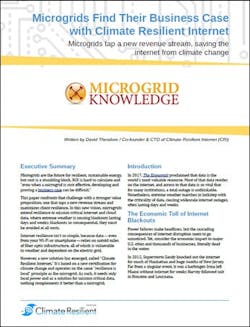Power failures make headlines as wildfires and hurricanes occur with increasing frequency. But the cascading consequences and economic impact of internet disruption often seem to go unnoticed.
Data and internet resilience is symbiotic with energy in the Digital Age, and bringing the two together into a microgrid does much to enhance its value and improve ROI.
This creates a big case for microgrids, according to the new report from Microgrid Knowledge and Climate Resilient Internet (CRI) that asks the following question: “Can you think of a better use case for microgrids than to maintain mission critical internet access?”
Get the full report.
Microgrids are the future for resilient, sustainable energy, but cost is a stumbling block, CRI points out. ROI is hard to calculate — and “even when a microgrid is cost effective, developing and proving a business case can be difficult.”
This paper confronts that challenge with a potentially stronger value proposition; one that taps a new revenue stream and maximizes client resilience.
In this new vision, microgrids extend resilience to mission critical internet and cloud data, where extreme weather is causing blackouts lasting days and weeks; blackouts so consequential, they must be avoided at all costs.
That said, internet resilience isn’t so simple, because data — even from your Wi-Fi or smartphone — relies on untold miles of fiber optic infrastructure, all of which is vulnerable to weather and dependent on the electric grid.
However, a solution has emerged, called “Climate Resilient Internet.” It’s based on a new certification for climate change and operates on the same “resilience is local” principle as the microgrid.
“We’re not just telecom leaders, but we’re also climate activists who are rooting for, and actively talking up the benefits of microgrids…The point is, we actually care about microgrids, and for all the right reasons.” — David Theodore, co-founder and CTO of Climate Resilient Internet
As such, it needs only local power. So as a solution for mission critical data, a microgrid is an ideal complement.
Why is internet infrastructure so vulnerable? Today, it’s wholly dependent on the electric grid and ground-based fiber optic cabling.
That may seem surprising as we live in what often seems like a wireless world. But CRI points out that data from your cellphone and other wireless devices switches over to fiber before reaching the internet.
The solution? According to the report, internet resilience requires independent power and carrier-class wireless to the nearest, hardened internet data center.
And once there, data can access available routes to its final destination.
Get the full report, courtesy of Climate Resilient Internet, “Microgrids Find Their Business Case with Climate Resilient Internet,”







